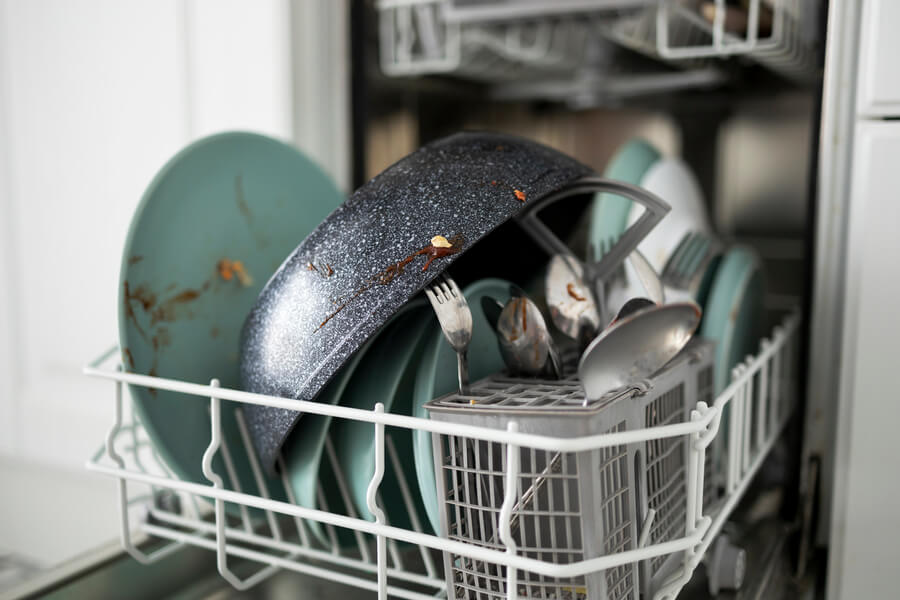Is your dependable GE dishwasher leaving your dishes cold and dripping after a wash cycle?

Don’t worry; we’ve got you covered. In this article, we’ll uncover the reasons behind a malfunctioning heating element in your GE dishwasher and guide you through practical solutions. The heating element in your dishwasher ensures spotlessly clean and dry dishes.
We’ll pinpoint the exact reasons for the heating element issue and provide you with straightforward, step-by-step fixes to restore your dishwasher’s peak performance. Let’s dive into these solutions and help you tackle this kitchen challenge.
Why is the heating element not working?
If your GE dishwasher’s heating element has failed, it will not dry dishes properly. It can be highly frustrating to deal with a very soggy set of plates. Several factors may be at play when your GE dishwasher’s heating element fails to perform its vital function.
In this section, we’ll discuss the common reasons behind your GE dishwasher’s heating element issues and solutions to tackle the problem.
1. Faulty wiring
Issues with the wiring can lead to inadequate electrical power being distributed to your dishwasher’s heating element. This causes it to burn out. Use a multimeter to test the heating element for continuity.
By so doing, you will know if it has burned our. If you observe that the heating element does not have continuity, it needs to be replaced. You may have to contact a technician to help you replace this, or check the steps below to do it yourself.
It is, however, essential to note that your GE heating element may have a fuse that can trip. This fuse can prevent voltage from reaching the heating element if it trips. In this situation, you only have to press the button on the fuse. This will reset it and restore power to the component.
How to replace the heating element?
- Get the necessary materials:
First, you must purchase all the materials to replace the faulty heating element. You have to get a replacement for the heating element. It is essential to get one that is compatible with your GE dishwasher.
Then, you need to purchase a screwdriver, wire cutters, wire strippers, electrical tapes, safety gloves, and goggles. Most importantly, you would need the GE dishwasher’s manual. This will help you understand the dishwasher’s layout and make the repair process more accessible.
- Prioritize your safety and turn off the water and power supply:
You have to turn off the water and power supplies to the dishwasher. Find the power source, then unplug the dishwasher from the wall outlet. The next thing you must do is find the valve that supplies water to the dishwasher and turn it off.
Check your GE dishwasher’s manual to determine the kind of spray arms your dishwasher has. Snap or unscrew the bottom spray arm, then remove the dish racks.
- Remove the dishwasher’s access panel:
You have to do this to access the heating element. Use a screwdriver to remove any screws holding the access panel in place. When you do this, remove the footplate that secures the dishwasher to the counters.
- Remove the dishwasher’s mounting brackets:
Use a screwdriver to unscrew the mounting brackets that hold the dishwasher to the countertop. After doing this, remove your GE dishwasher from under the counters and away from the wall.
- Disconnect the dishwasher’s wires and remove the heating element:
Locate the nuts that connect the heating element to your dishwasher. They are usually by the side of the bottom of the dishwasher. Pull the wires attached to the mounting nuts, then use a crescent wrench to remove the nuts. Once you do this, remove the heating element from its housing.
- Install the new heating element:
When you remove the heating element, gently grease the new heating element using a rinse aid. Then, you have to slide it into the housing until you notice that it has clicked into place. Reconnect the wires you initially disconnected. Pour a little bowl of water into the tub, and if you have any leaks, you need to tighten the heating element’s mounting nuts.
- Reattach the water hoses:
After you have done all the above, put your GE dishwasher back into position, reattach the water hoses, and restore the power and water supply. Then, do a test run to check if the dishwasher is functioning optimally.

2. Wear and tear
Your dishwasher’s heating element may malfunction because of the wear and tear it has endured during operating cycles. If this is the case, then you will need to replace it. You can follow the steps in the previous section to do this.
3. Corrosion
This may not cause severe issues for the heating element at first; however, it can cause small cracks that can cause it to burn out. In this situation, the heating element also needs to be replaced.
4. Broken Element
Another possible cause of your dishwasher’s faulty heating element may be constant heating and cooling. This may lead to cracks in the heating elements. These cracks affect how well the heating element functions. You will need to install a new heating element in this situation.
5. A faulty thermostat
A thermostat sets temperatures, and the heating element uses this tool to perform its functions. A faulty thermostat will prevent the heating element from functioning effectively. The thermostat may need a replacement.
The thermostat turns off the heater before your dishwasher overheats. If the thermostat has problems, it could be cutting your GE dishwasher’s heating cycle short before your dishes are dry. You have to check for electrical continuity by using a multimeter.
If there is no continuity, then you need to replace the thermostat. Luckily, it is a cheap part, so you can easily return it. Follow the steps below to do this.
- The first thing you have to do is to unplug the dishwasher from the power source. This is for safety purposes.
- After doing this, the next thing you have to do is remove the outer door and control panels. You must remove the Torx screws from the inner door panel to do this. You have to support the outer door panel with your hand while you remove the screws so the door panel doesn’t fall. Once this is done, you have to separate the outer door panel and the control panel from the inner door panel. Rest the outer panel on the floor, then disconnect the user interface control wire harness from the dishwasher’s control panel. Once you do this, pull out the outer door and control panel.
- Then, you must use a nut driver to remove the bottom front access and toe panels.
- Pull wires from the old thermostat, then release the mounting bracket from the dishwasher frame and remove the metal mounting bracket and the dishwasher’s thermostat. Remove the thermostat from the mounting bracket and install a new one into the mounting bracket.
- After you do this, you need to place the toe panel on the dishwasher and then put the access panel in front of the toe panel. Put in the mounting screws and tighten the screws.
- Put the outer door panel and control panel close to the inner door, then reconnect the user interface control wire harness. When doing this, you must attach the outer and control panels to the inner door panels.
- After this, you have to reinstall the dishwasher’s mounting screws.
- Finally, restore electrical power.
That is fine if you feel uncomfortable changing these parts yourself. All you have to do is contact a technician to help you do it for a fee.

Conclusion
A malfunctioning heating element in your GE dishwasher can be a source of frustration. Still, with a better understanding of the causes and practical solutions, you can restore your dishwasher’s performance and ensure your dishes come out clean and dry.
Whether it’s testing for continuity or replacing parts, we’ve provided clear steps to get your dishwasher back to its optimal performance. So, next time your dishes come out cold and dripping, you’ll know what to do. You can bid farewell to soggy dishes with these solutions in your toolkit.
